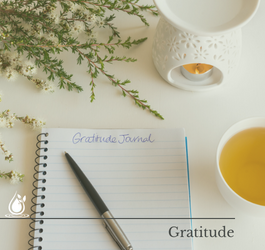The reality of our existence is that we get out of the world what we put into it. One that is continuously putting negativity out into the world is only going to see that same negativity reflected back to them. In the same way, if we are choosing to notice all of the good that comes out of this world and put that same goodness back in, we are going to feel far more fulfilled and happy. Being grateful sounds like something that should be easy to implement, but in reality, practicing gratitude in everyday life is much harder than it may seem. Here at Jade Bloom, we are aware of the incredible changes that can come about from improving one’s ability to practice gratitude, so we have provided a guide to the science behind gratitude as well as specific steps you can take to improve your practice of gratitude on a daily basis.
The Benefits of and Science Behind Gratitude
Relieves Stress
Practicing gratitude can help relieve stress and pain as well as calm the nervous system. According to Mindful.org, “the regions associated with gratitude are part of the neural networks that light up when we socialize and experience pleasure.” These same regions are also connected to the same parts of the brain responsible for emotion regulation and stress relief. Practicing gratitude leads to a more relaxed body state, decreased stress, and the subsequent benefits of both. “Physiological changes associated with gratitude are typically a reduction in blood pressure and increase in vagal tone, which is taken as an index of increased parasympathetic influence on the peripheral nervous system,” says Dr. Emiliana Simon- Thomas, Science Director at the Greater Good Science Center. When practicing gratitude, the parasympathetic nervous system works to help conserve energy and promote relaxation, which in turn helps to reduce stress and anxiety.
Helps with Depression
Practicing gratitude can greatly help those with symptoms of depression. In a study conducted by researcher Prathik Kini and colleagues and Indiana University, they discovered how “practicing gratitude can alter brain function in depressed individuals”. They found that gratitude can “induce structural changes” in the parts of the brain involved with experiencing depression. As a result of the study, they determined that gratitude is so powerful it has the ability to “change and re-wire the brain” (Mindful).
Another study took a random group out of almost 300 adults in need of counseling for their depression and had them write a letter of gratitude once a week for three weeks. Following the three weeks, the group assigned to write the gratitude letters reported much better mental well-being when compared to that of the control group when they were revisited 12 weeks after the study (Mindful). This is not to say that depression can be cured through means of practicing gratitude, but integrating into our daily life the habit of paying attention to our surroundings and what we are grateful for within them certainly can help.
Boosts Immunity and Heart Health
General research from the last decade has shown that those that practice gratitude regularly have less health complaints. A specific study that corroborates this took a group of college students and had them write about things they were grateful for over the course of 10 weeks. This group reported far fewer physical symptoms than the two control groups. A study exploring the impact of gratitude on heart health took a group of “heart-failure patients who were randomly assigned to either an eight-week gratitude-journaling group or a treatment-as-usual group”. The study “found that patients in the gratitude group showed more parasympathetic heart-rate variability, which is a sign of better heart health” (Mindful).
Improves Relationships and Connections
Practicing gratitude can help to improve your relationships with people in your life. A study from the PAW Laboratory at UC-Riverside studies high school students who report on the impact of practicing gratitude on their daily lives. Along with feeling more positive emotions and a desire to improve, these students felt compelled to ameliorate their relationships with loved ones and give back to those same relationships the positivity and beauty they felt they were getting out of the world (Mindful).
Gratitude can also improve and assist in maintaining healthy romantic relationships. Practicing gratitude helps one be reminded of the positivity and value in a relationship and it can lead to a cycle of generosity and gratitude for one another. According to Mindful.org, “Gratitude may also open the door to healthier communication styles within a relationship. Since the practice leads to more positive perceptions of our partners, friends, or family (and likely, greater trust), we may feel more comfortable talking through disagreements. In one study, participants who expressed gratitude toward a romantic partner or close friend reported greater ease when voicing relationship concerns in the future”. Practicing gratitude in your relationships on a daily basis will likely lead to better communication, stronger connection, and increased trust.
How to Implement Gratitude in Your Life
General Practices
Being able to regularly practice gratitude is something that takes time and patience. If you regularly bring your attention to the things you are grateful for, you will start to find more and more things to be grateful for. Begin by observing the thank yous you say and how often you find yourself feeling grateful for the little things. Once you increase your awareness of those moments, stop before you say it and make yourself aware of just what it is you are thankful or grateful for in that moment. Then say thank you. Thank you’s can start to feel vapid and empty over time, so taking the time to really think about what we are saying thank you for can help to cultivate a more genuine and grateful mindset.
Be more present in each and every moment and notice what you can sense and observe. How do those things make you feel? Be especially conscious of the way and how often you express your gratitude to and for your loved ones to strengthen those relationships. Spread that gratitude to all areas of your life, including social media and that will increase the overall positivity and gratitude of a space that tends to be overly critical.
Specific Things to Implement
Here are 10 specific easy ways to practice daily gratitude according to Jon Kabat-Zinn and Mindful.org.
-
Keep a Gratitude Journal
-
-
Establish a time every day that you have set aside to reflect on the day and write down the parts of the day you are grateful for. Life can get busy and stressful, so it can be hard in the moment to remind yourself what you are grateful for. By having a specific time dedicated for reflection and gratitude, you are forcing yourself to come up with moments of joy and positivity in your life and by allowing yourself room to see them, they become much more abundant.
-
-
Use your Breath to Anchor Yourself
-
-
Being able to be grateful comes from the ability to be present in any given moment. If you are having a hard time staying positive, or going through a particularly difficult time, focus on your breath and the world around you to find presence in that moment. Use the nonjudgmental space you have created to reflect on what you are grateful for right then and there.
-
-
Ask Yourself Three Questions
-
-
Reflect on the relationships with people in your life and explore the following questions: What have I received from ____? What have I given to ____? How can I improve my relationship with ____? By bringing this amount of awareness into your reflections of your relationships, you will be able to use gratitude to improve them.
-
-
Share your Gratitude with Others
-
-
When you are feeling particularly grateful about anything, be sure to express this gratitude to those involved and those in your life. Sharing gratitude with others has been shown to strengthen relationships.
-
-
Come to Your Senses
-
-
When you are having a hard time finding reasons to be grateful, focus on your senses: the things you can see, hear, touch, smell, and taste. By bringing your awareness to the most simple things you can sense and observe, you can begin to find gratitude for the most basic human experiences. This also allows for a greater sense of presence which creates a greater space for finding gratitude.
-
-
Use Visual Reminders
-
-
“The two primary obstacles to gratefulness are forgetfulness and a lack of mindful awareness” (Mindful). Because of this, it can be helpful to further utilize your sense of sight and rely on it to trigger those thoughts of gratitude. An example of good visual reminders is simply seeing other people.
-
-
Make a Vow to Practice Gratitude
-
-
It’s been shown that making an oath to implement a specific behavior increases the likelihood of that behavior being initially adopted and committed to long term. If your intention is to increase the frequency with which you practice gratitude, try having a physical written copy of that oath and put it somewhere where you can be regularly reminded and keep yourself accountable.
-
-
Watch Your Language
-
-
The way you speak about things and the language that you use will likely become a reality in your life. If you are using negative language and speaking about specific experiences in a purely negative light, you will continue to view your life in that same negative light. Similarly, if you are speaking positively and using positive language in regards to your experiences, it will become your reality and you will find yourself far more grateful for each and every experience.
-
-
Go Through the Motions
-
-
Just as positive language brings on positive thoughts and feelings, positive motions do the same. Using motions of gratitude like smiling, saying thank you, and writing letters of gratitude, you will find that gratitude begins to become reality. This is the idea that you should act the way you want to feel and it will soon be true.
-
-
Think Outside the Box
-
-
Use your creative mind to come up with new ways to express your gratitude in your life, whether that be expressing your thanks in new ways to those in your life or finding new, creative ways to reflect on your gratitude yourself.
-
Our Take on Gratitude
In an effort to assist you on your journey to make a conscious effort to focus on what you are grateful for, we at Jade Bloom have formulated an essential oil blend specifically for creating an atmosphere perfect for practicing gratitude. Our Gratitude Blend, A Blend for Appreciation, contains Sweet Orange, Coriander, and Juniper Berry essential oils. It comes in a 10 mL bottle, a prediluted roller-ball bottle, and a lip balm version. This blend is best used aromatically: diffuse a few drops for 15 to 30 minutes a couple of times daily in your diffuser. Try doing so in the morning as your day begins, or at the end of the night as you reflect on your day.
There are innumerable benefits to regularly practicing gratitude, including, but definitely not limited to, improving your mental health, boosting your physical health, and strengthening your relationships. Overall, gratitude is a practice that can help you discover the tranquility and joy you have the potential to experience every day of your life. By slowly implementing this healthy habit into your life and daily schedule, you will find yourself full of love and gratitude to an extent you never thought possible.









